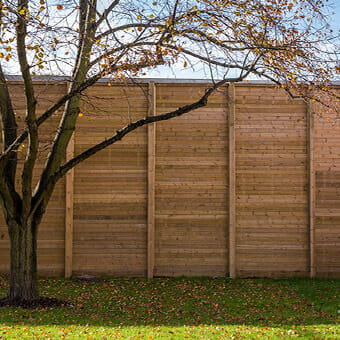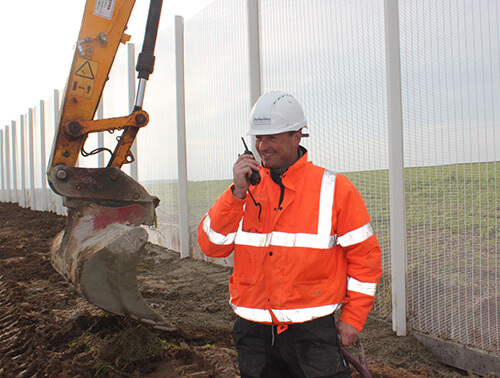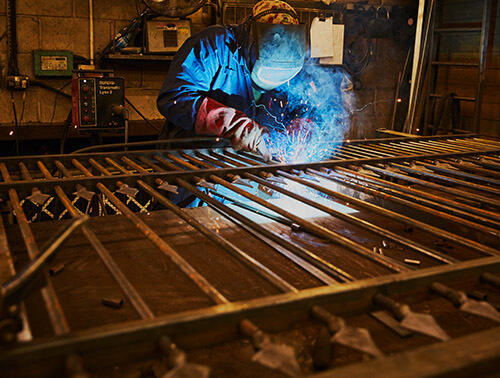Our other sites:
When most people think of 358 mesh fencing, they imagine secure perimeters around prisons, data centres, or utilities. Its tightly woven design and anti-climb properties make it a trusted choice where safety and durability matter most. However, what is less well known is how this same fencing type can actually contribute to healthier, more resilient habitats for wildlife. With careful design and installation, 358 mesh can become part of a balanced landscape that supports both security and biodiversity.
Understanding 358 Mesh
358 mesh fencing gets its name from its dimensions: 3 inches by 0.5 inches by 8 gauge. We explore what makes a good 358 mesh panel in our blog post. The apertures are small enough to prevent climbing and cutting, but large enough to allow excellent visibility, airflow and light transmission. This subtle transparency is key to its potential environmental benefits.
Because the mesh has a fine, consistent pattern, it almost disappears into the landscape when viewed from a distance. This “invisible” quality allows it to blend naturally into green or rural environments; it becomes part of the background rather than a dominant visual feature. In sensitive locations, such as near nature reserves or rail corridors, this minimal visual intrusion can make a significant difference to both people and wildlife.

Protecting Habitats Without Harm
In sensitive areas such as nature reserves, wetlands, or woodland edges, 358 mesh fencing can create clear but non-invasive boundaries. It prevents vehicles, livestock, or unauthorised access from disturbing delicate ecosystems. Because the fence is see-through, it reduces the sense of confinement and maintains a sense of openness within the landscape.

This is particularly valuable along rail networks, where fencing is essential for safety but also needs to coexist with wildlife. Network Rail and other infrastructure operators often use 358 mesh to secure railway perimeters while maintaining ecological connectivity. The mesh prevents larger animals from entering dangerous areas but still allows smaller creatures and pollinators to pass safely nearby. When paired with wildlife tunnels, overpasses or designated crossing points, 358 mesh becomes part of a wider system that protects both people and nature.
Hedgehogs and Humane Design
V mesh and chain-link fencing often have larger gaps that can trap mammals like rabbits and foxes. Hedgehogs in particular are at risk; they can squeeze through wider mesh openings but then become stuck, leading to injury or death. The fine, uniform spacing of 358 mesh prevents this from happening. Hedgehogs cannot get through the fence, but they also cannot become entangled in it. In this way, the fence acts as a safe barrier that still respects the movement patterns of these important garden and woodland creatures.
For sites where hedgehog passage is desirable, small purpose-built openings can be left at ground level. This approach combines the safety benefits of 358 mesh with habitat connectivity, ensuring that hedgehogs and other ground mammals can continue to roam freely between foraging areas. Thoughtful placement of these access points can help link habitats and maintain local population health. We discuss hedgehog friendly security fencing in more detail in our blog post.
A Fence That Lets Nature Breathe
Because 358 mesh is open to light and air, it allows the surrounding environment to remain vibrant. Vegetation can grow right up to the fence line, and the fine structure provides natural support for climbing plants such as ivy, honeysuckle and other native climbers. Over time, this can transform a plain fence into a living green boundary. Such growth offers food and shelter for pollinators, nesting birds and beneficial insects; it also softens the visual impact of the fencing and blends it into the natural landscape.
In urban or semi-industrial sites, this quality is particularly important. Many developers now integrate biodiversity net gain principles into their planning, ensuring that every project leaves the environment in a better state than before. 358 mesh supports this by enabling the creation of “green screens” that contribute to habitat corridors, reduce noise, and promote local flora and fauna.
Supporting Biodiversity Near Infrastructure
Many utility or infrastructure sites now incorporate biodiversity plans into their operations. 358 mesh fencing is particularly useful in these contexts; it provides security without creating the ecological barriers that solid fences or walls often impose. Birds can fly over; amphibians can pass beneath; insects can move freely through. The result is a more connected and sustainable environment even in areas that require strict perimeter control.
For example, along energy installations or water treatment plants, 358 mesh helps balance operational safety with environmental responsibility. When combined with native planting schemes and sustainable drainage features, these fenced perimeters can become thriving microhabitats. The mesh allows sunlight and rain to reach the plants, supporting the establishment of wildflower meadows and nectar-rich borders that attract bees and butterflies.

The Balance Between Security and Sustainability
As land use becomes increasingly complex, it is vital to find solutions that meet human needs without undermining the health of local ecosystems. 358 mesh fencing demonstrates how security infrastructure can evolve to play a role in environmental stewardship. It protects sites effectively, yet its design characteristics allow the surrounding wildlife to thrive rather than struggle.
By choosing 358 mesh and pairing it with thoughtful landscape management, such as native planting, hedgehog access points or climbing vegetation; developers, conservationists and landowners can achieve a rare balance between practicality and compassion. The fence’s almost invisible presence, durability, and versatility make it a long-term solution that benefits both people and the planet.
358 mesh fencing is far more than a tool for security; it is a modern example of how design can serve both people and nature. When installed with awareness of local wildlife needs, it helps create spaces that are safe, breathable and ecologically connected. Hedgehogs and other animals stay protected, habitats remain intact, and biodiversity continues to flourish alongside human infrastructure.
Related Products
Jacksons Fencing have a large range of related products, all complete with our 25 year guarantee. If you cannot find the item you are looking for, please do not hesitate to call our friendly sales team.
Related Content
Top






